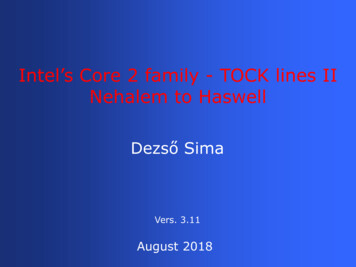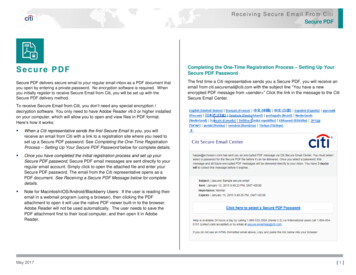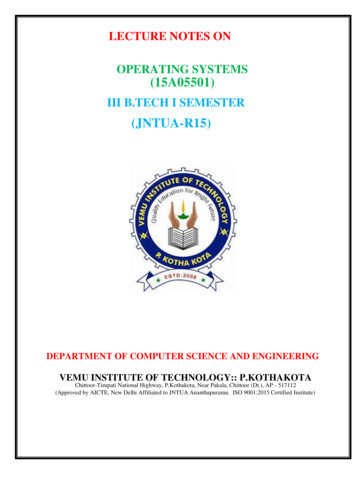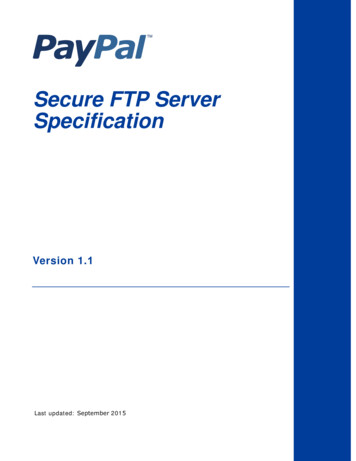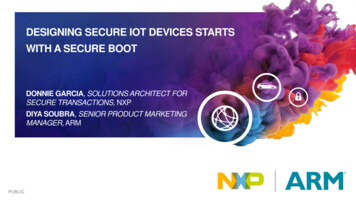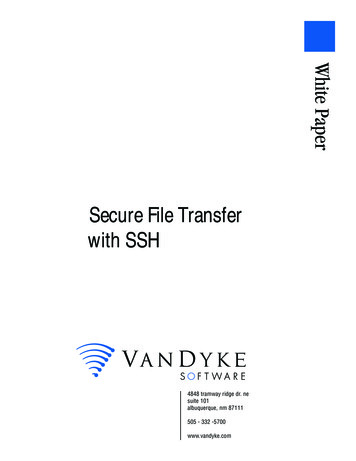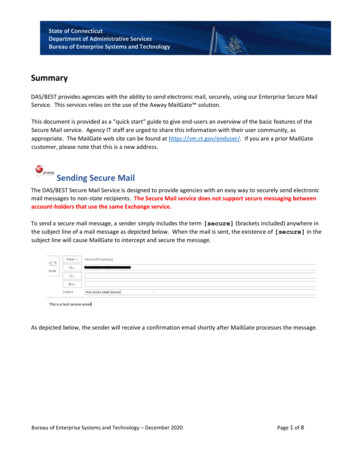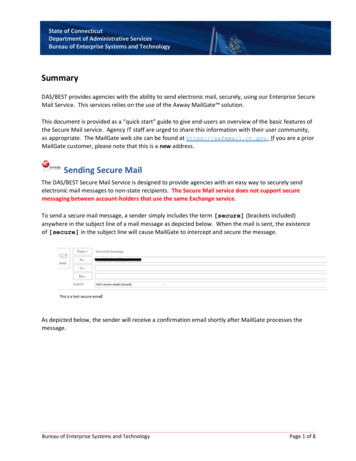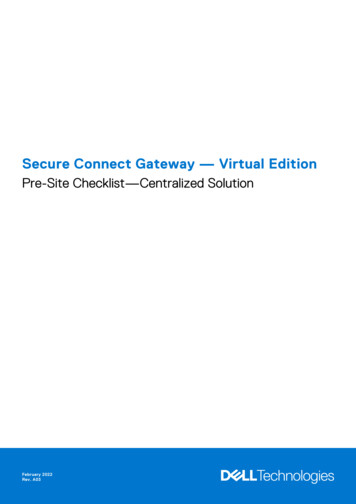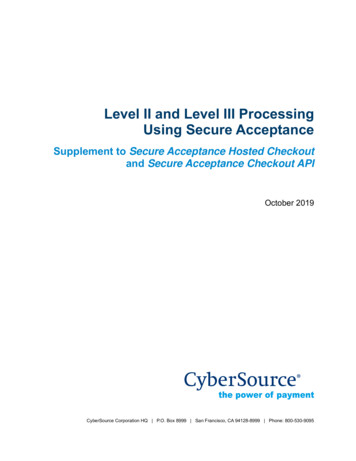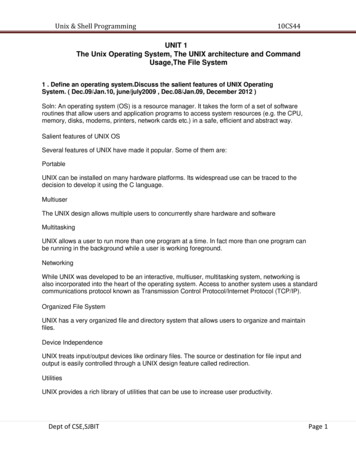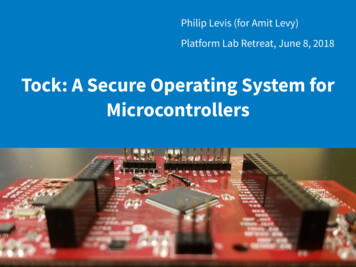
Transcription
Philip Levis (for Amit Levy)Platform Lab Retreat, June 8, 2018Tock: A Secure Operating System forMicrocontrollers
Limitations of Microcontroller Sofware Low memory: 64 kB RAM No virtual memory Can’t use Linux! No isolation USB authentication keys have multiple functions Sensor networks run several experiments at once Fitness watches support diferent activities2
Multi-User Device: SignpostModular city-scale sensing Tracking Ambient conditions Pedestrian density Noise monitoring8 pluggable modules Microcontroller SensorsSeveral applications per moduleCurrently deployed @ U.C. Berkeley3
OTA Updates: Helium End-to-end IoT “solution” Programmable module–Long-range radio–MCU runs customer services applications Abandoned a previous version that used Lua Next version uses Tock4
Security Sensitive Device: Google Titan Google’s Titan chip: security hardened MCU Server root-of-trust, authentication Without Tock: a handful of experts audit all code Open source port of Tock started during internship5
Thesis: Embedded Devices areMultiprogrammed Becoming platforms Multiple users running applications concurrently Applications updated dynamically –Small payloads better–Buggy updates shouldn’t brick devicesSecurity sensitive devices require least privilege6
Tock Embedded OS Growing open-source community–883 GitHub followers, 100 mailing list subscribers–54 contributors (so far) to main project– 20 contributors to out-of-tree HW ports– 100 developers trained at Tock tutorialsGrowing HW support–ARM Cortex-Ms: Atmel SAM4L, Nordic NRF5x, TI CC26xx& TM4C129x, NXP MK66, STM32–RISC-V port at a secret facility outside Boston
Multiprograming a Microcontroller1.Memory & Performance Isolation2.Power & Clock Control3.Future work8
Example: USB Authentication Key Multiple independent applications No programmability in favor of security Result: Handful of programmers control sofware stack9
Platform ( 10 developers) Build the hardware Responsible for TCB: core kernel, MCU-specific code Trusted: complete control over firmware & hardwareGoal: possible to correctly extend TCB10
OS Services ( 1000 developers) Most OS services come community– Device drivers, networking protocols, timers.Platform provider can audit but won’t catch all bugsGoal: protect kernel from safety violations11
Applications ( 20M developers) Implement end-user functionality “Third-party” developers: unknown to platform provider Potentially maliciousGoal: end-users can install 3rd-party apps12
Need New Isolation Techniques With 64 kB, malloc a serious threat to system stability No virtual memory Still need to solve driver isolation–GC’d languages & hardware isolation too resource heavy13
New Tools AvailableMemory Protection Unit (MPU) Protection bits for 8 memory regions Isolate processes for applicationsRust Non-GC'd type-safe systems language Prevent safety violations in kernel at very low cost14
Tock: A Microcontroller OS Processes: Use the Memory Protection UnitCapsules: Type-safe Rust API for safe driver developmentGrants: Bind dynamic kernel resources to process lifetime15
Tock’s Isolation MechanismsTotally untrustedTrusted for liveness, not safetyProcesses Standalone executable in any language Isolation enforced at runtime Higher overhead ApplicationsCapsules Rust code linked into kernel Isolation enforced at compile-time Lower overhead Used for device drivers, protocols, timers.16
Processes Hardware-isolated concurrent programs in any language–MPU to protect memory regions without virtualization–Independent stack, heap, static variables Run dynamically, compiled with position independent code Scheduled preemptively System calls & IPC for communication17
Capsules A Rust module and structs Single-threaded event-loop with asynchronous I/O Single stack No heap Communicate via references & method calls, ofen inlined18
Capsule Resource OverheadExample 1: “blink”ROM size (B)RAM size (B)Tock3208916TinyOS529672ROM size (B)RAM size (B)Tock417449704TinyOS3960410460Example 2: Networked sensor19
Capsule Isolationstruct DMAChannel {length: u32,base ptr: *const u8,}impl DMAChannel {fn send buffer(&self, buf: &'static [u8]) {self.length buf.len();self.base ptr buf.as ref();}} Exposes the DMA base pointer and length as a Rust slice Type-system guarantees user has access to memory Won’t be deallocated before DMA completes20
Safe Dynamic KernelAllocation21
Working Example: Sofware TimerSofware TimerKernelHW Alarm22
Statically allocate timer state?LIFASofware Timer DriverStatic allocation must trade of memory eficiency andmaximum concurrency23
What About Dynamic Allocation?LIFAAES DriverSofware Timer DriverBluetooth DriverCan lead to unpredictable shortages.One process’s demands impacts capabilities of others.24
Grants: Per-Process Kernel Heaps Allocations for one process do not afect others System proceeds if one grant section is exhausted All process resources freed on process terminationGrant yCode25
Grants: Per-Process Kernel HeapsSofware Timer DriverGrants balance safety and reliability of staticallocation with flexibility of dynamic allocation26
Grants use the type-system to ensure references only accessible whenprocess is live// Can’t operate on timer data heretimer grant.enter(process id, timer {// Can operate on timer data hereif timer.expiration cur time {timer.fired true;}});// timer data can’t escape herefn enter 'a, F (&'a self, pid: ProcId, f: F) where F: for 'b FnOnce(&'b mut T)27
Multiprograming a Microcontroller1.Memory & Performance Isolation2.Power & Clock Control3.Future work30
Power State & Clock Control RCFASTRCSYS Power draw combo of duty cycle and active draw– What’s the deepest sleep state we can drop to?– Which clock should drive active peripherals?Multiprogramming makes both harder!Impact of Active Clock SelectionDuty Cycle a Function of Workload31
Multiprograming a Microcontroller1.Memory & Performance Isolation2.Power & Clock Control3.Future work32
Future Work Writing & Enforcing security policies–For the kernel: language-based capability system?–For processes: permissions without a file system?–For networked applications: cryptographic tokens?Debugging embedded applications–Security implications–LoggingMore applications, more hardware–RISC-V, x86–Wearables, sensor networks, security devices33
Tock: A Secure Operating System forMicrocontrollers Embedded devices are multiprogrammable– Security, Sofware Updates, Multi-tenancyTension between isolation and resources–Traditional approaches insuficient for low memory–New programming languages & hardware features helpMust also rethink: power management, networking,security policies.34
Thank you!35
Tock on SignpostEach Signpost module runs a Tock kernelAmbient ModuleAudio ModuleProcess LoC69906688Capsules LoC44793985Platform LoC32523244405 “unsafe”381 “unsafe”36
Writing Applications?Energy consumption on Signpost applications**Adkins et al., IPSN’1837
Future Work with TockEficient Clock Management Can’t statically choose clock domains Idea: Hide clock choices from appLow-power wireless networking 6lowpan implementation overheads Multi-application Bluetooth Low-Energy peripheralsSecurity Policies Specify access rights for processes/apps Enforce high-level policies on capsulesTagline: An “App Store” for embedded systems38
Rust Features Type and memory safe– Compile-time enforced type system– No type artifacts at run timeNo garbage collection– No bufer overflows, dangling pointers, type confusion,use-afer-free Control over memory layout and executionRuntime behavior similar to C39
Rust’s OwnershipKey Property: Deallocate memory as soon as owner out of scope{let x Resource::new();}When the scope exits, x is no longer valid and the memory is“freed”{let x Resource::new();let y x;println!(“{}”, y); // OK: value movedprintln!(“{}”, x); // compilation error!}40
Borrowingfn transform(x: &mut Resource) {// the borrow is implicitly released.}let mut my resource Resource::new();transform(&mut my resource);// my resource still valid hereJust a pointer at runtime Mutable references (&mut) must be unique Shared references (&) cannot mutate the value41
Sum Types vs. Shared Mutabilityenum NumOrPointer {Num(u32),Pointer(&mut u32)} rustc test.rsassign to ‘external‘//error[E0506]:n.b. will cannotnot compilebecause it is borrowedlet external : &mut NumOrPointer;if let Pointer(internal) external {*external Num(0xdeadbeef);*internal 12345;// Kaboom: we’ve just written ‘12345‘// to the address ‘0xdeadbeef‘}Existential types for imperative languages, Dan Grossman, ESOP’0242
Interior MutabilitySafe if we avoid mutability aliasing concurrentlyExamples from Rust core library: Cell: Copy-in/out or replace, no direct references Mutex: mutual-exclusion on internal referenceCan write our own with diferent semantics: TakeCell: non-blocking mutual-exclusion–Used in Tock for storing large bufersDeveloper expresses: Which part of data is mutable?43
Tock Embedded OS Growing open-source community - 883 GitHub followers, 100 mailing list subscribers - 54 contributors (so far) to main project - 20 contributors to out-of-tree HW ports - 100 developers trained at Tock tutorials Growing HW support - ARM Cortex-Ms: Atmel SAM4L, Nordic NRF5x, TI CC26xx & TM4C129x, NXP MK66, STM32 - RISC-V port at a secret facility outside Boston
